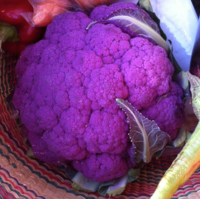
Photo from wikipedia
ATP-citrate lyase (ACL) gene catalyzes the formation of acetyl-CoA to provide intermediate precursors for many secondary metabolites, and also plays an important role in anthocyanin biosynthesis of plants. Herbaceous peony… Click to show full abstract
ATP-citrate lyase (ACL) gene catalyzes the formation of acetyl-CoA to provide intermediate precursors for many secondary metabolites, and also plays an important role in anthocyanin biosynthesis of plants. Herbaceous peony (Paeonia lactiflora Pall.) is an international cut flower known for its rich flower colors, however, the function of the ACL gene in flower color regulation is still unclear. Here, double-colored P. lactiflora ‘Hebao Jinlian’ were used to study the molecular mechanism of red petal, and acetyl-CoA and anthocyanin biosynthesis related PlACLB2, PlCHS, PlDFR, PlANS, and PlbHLH1 genes were initially found to highly expressed in the red outer-petals. The expression pattern of PlACLB2 was consistent with the spatial accumulation of anthocyanins. The correlation analysis of PlACLB2 expression pattern, acetyl-CoA content, and anthocyanin accumulation revealed that PlACLB2 was positively correlated with the acetyl-CoA and anthocyanin contents with correlation coefficients of 0.82 and 0.80. Moreover, multiple sequence alignment identified two typical conserved domains in PlACLB2, and phylogenetic analysis clustered PlACLB2 into the ACLB clade. PlACLB2 was localized in the nucleus and cytoplasm. On the one hand, silencing PlACLB2 in P. lactiflora red outer-petal resulted in lighter petal color and decreased acetyl-CoA accumulation, and quantitative analysis detected that PlACLB2-silenced petals lost more anthocyanins than the control groups with a decrease of 31.0%, and the main pigment component cyanidin-3,5-O-diglucoside was reduced by 31.9%. On the other hand, overexpression of PlACLB2 significantly promoted red coloration, acetyl-CoA content, and anthocyanin accumulation in tobacco flowers. These results demonstrated that PlACLB2 promoted anthocyanin accumulation by increasing the abundance of its precursor substrate acetyl-CoA, thereby regulating the formation of the red petals in P. lactiflora.
Journal Title: Frontiers in Plant Science
Year Published: 2022
Link to full text (if available)
Share on Social Media: Sign Up to like & get
recommendations!